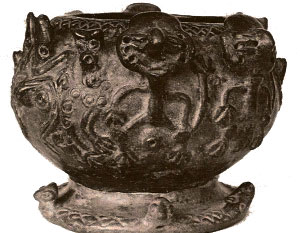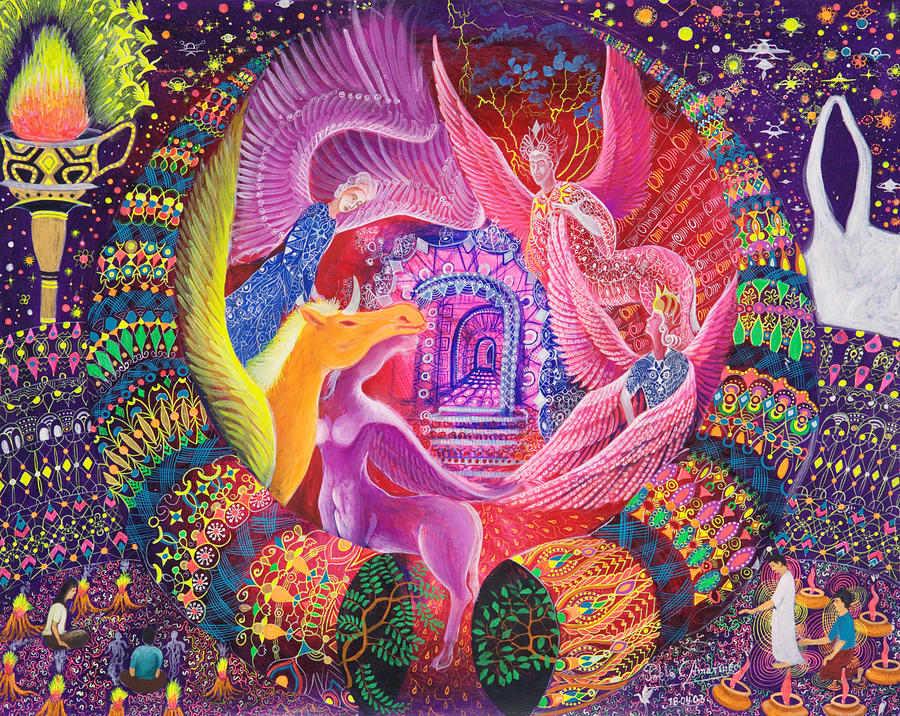(Picture above) Credits Geens Archenti Flores
For thousands of years Ayahuasca has been watching over the native peoples of the Amazonian basin of South America. Whether for medicinal, social or spiritual purposes, it is part of their lifestyle and accompanies them throughout their lives. For thousands of years she has been caring for them, enlightening their vision, helping them to hunt, to fish, to color their dreams … It is found in Peru, Bolivia, Venezuela, Ecuador, Colombia, Brazil … It is even used today by about 75 ethnic groups throughout the Amazon basin and may well be over 2500 years old! During an archaeological dig conducted a few years ago in Quito, Ecuador, traces of Ayahuasca were found in a ceremony cup (see photo below). Ayahuasca is definitely a “magic potion” crowned with mystery. One of the first puzzles lies in the secret of his preparation, a thorny problem raised by Jeremy Narby in 1995 in his book “The Cosmic Serpent”. How could this beverage from the combination of two plants be found among more than 80,000 plant species found in Amazonia? The probability that his discovery would have been fortuitous is almost impossible.
Probability calculation: 80000 x 80000 = 6400000000. The probability that Man has discovered Ayahuasca by chance is 1 in 6.4 billion chance about 36 times more unlikely than pulling the winning numbers of the Powerball !
Many Stories circulate about it
«At the time of our grandfathers, we did not have access to hospitals. There were no dispensaries, no drugs. We were isolated in the forest and each family was a nucleus that needed to be nourished and protected. Our ancestors did not have access to what we have now, so they had to look in the forest for the plant that could cure a fever, a wound, stomach pains, indicate places where to find animals, fish, etc. ... Little by little, through determination and experimentation, our ancestors shaped our medicinal science. By questioning the world around them, asking for solutions to heal, their dreams showed them a special plant that they would soon meet on their way. So the need to survive has led my people to find medicinal plants and to build close relationships with them.»
— Testimony of a curandero shipibo
«In my family there is a story about the discovering of Ayahuasca and its medicine. A grandfather who wanted to heal his family went to isolate himself in the forest. After a few days sitting in meditation without eating or drinking, the energy of the nearby Ayahuasca came into his dream telling him to drink its tea. By drinking only Ayahuasca and meditating, the Ayahuasca came back into his dream. She told him she would help to turn him to doctor but he has to learn to diet. And that's how the spirit of Ayahuasca began to turn us into doctors.»
— Testimony of a curandero shipibo

According to some shipibos the recipe for the preparation of Ayahuasca would have been given by the “Incas” wo were endowed with great knowledge. A story commonly heard in the shipibo communities bordering the Ucayali River, speaking of Inca spirits who appeared “in broad daylight” draped in their traditional clothes to give medicine of Ayahuasca and share their medicinal knowledge with their people. For other communities, cooking was reported to have been discovered by chance after children threw chacruna leaves into the ayahuasca pot. However this hypothesis as explained above seems very improbable … Others say that when using other “visionary plants” like the Toé* (Datura Brugmantia), these tribes would have had the intuition to combine these two plants between them. It is possible that none of these stories are true or on the contrary that they are all true if one takes into account the extent of the use of Ayahuasca throughout the Amazon basin. Yet according to Steve Beyer, the discovery of Ayahuasca seems rather from an area in Ecuador in the Napo River Valley, a tributary of the Amazon particularly conducive to inter-tribal river trade. In his book “Singing to the Plant”, he bases himself on the works of Brabec of Mori, Gow, and on his own observations affirming that the commercial and cultural exchanges practiced at all times by the natives of the Amazon allowed Ayahuasca to extend to all the Amazon basin.
* What is Toé ?
Ayahuasca History from Westerners Perspective

In the 16th century the Spaniards embarked on the exploration of the Amazon basin. During this trip, they condemned in their journals some shamanic practices such as the use of Wilka* and tobacco, but at this time no reference is made about the Ayahuasca ceremony or the drink of Ayahuasca. It was only in the 18 th century that the Jesuits made reference to the use of Ayahuasca. It was then described as a poisoned drink used for mystical experiences and witchcraft rituals. It was not until the middle of the 19th century that an English botanist , Richard Spruce, discovered Ayahuasca first among the Tukano tribes of Brazil under the name of caapi. His research would lead him two years later to tribes in Peru and Ecuador around the same drink but this time called “Ayahuasca”. His studies would not be published until 30 years later and the analysis of active principles of Ayahuasca would be undertaken at the beginning of the 20 th century. Scientists at that time succeeded in isolating the alkaloid contained in the liana of Ayahuasca, and then called it telepathine. In the middle of the 20th century, we finally managed to isolate the DMT. The main active principles of Ayahuasca are then listed and cataloged but its alchemy still eludes us …
* What is Wilka ?
Meanwhile a pioneer of the psychedelic movement is about to embark on an initiatory trip. In 1953, William S. Burroughs, the author of “Junkie” landed in South America via Panama with the intention of drinking Ayahuasca to develop its dreamlike potential. His journey will take him from Colombia to Ecuador, ending in Pucallpa, Peru. In 1960 it was his poet friend Allen Ginsberg’s turn to visit the Peruvian Amazon. Later they will write “the letters of Yagé” (Yagé is another name for Ayahuasca) emblematic work of the Beat Generation. Other authors will follow in their footsteps, such as Peter Matthiessen, W.S. Mervin, but also the Peruvian novelist Vargas Llosa and his compatriot the poet Caesar Calvo. Finally scientists such as Wade Davis or Alberto Villoldo will try to unravel the secrets of Ayahuasca in a process of personal experimentation. In 1983, Dennis McKenna, the brother of Terrence McKenna (known for his work on hallucinogenic mushrooms), unveils Ayahuasca by describing, with the help of other scientists, the role of MAO inhibitors in Ayahuasca. sine qua non for the DMT extracted from chacruna leaves to deliver its psychoactive properties.

Since the 1970s, the Ayahuasca experience has not stopped growing in popularity. Followers of psychedelic experiences and the New Age movement come to learn Ayahuasca. At the same time, Peruvian artists such as Pablo Amaringo draw inspiration from their visions under Ayahuasca, paving the way for a very flourishing visionary art. Ayahuasca is now becoming a real social phenomenon, opening a new chapter on the therapeutic use of psychotropic plants.

Comments